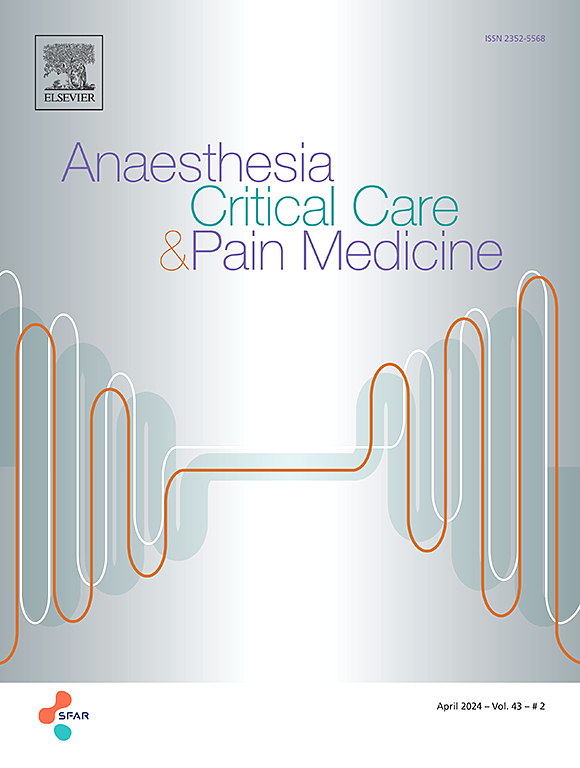Impact of direct oral anticoagulant treatment on management and outcomes of patients with hip fractures by monitoring assays. A population-based study of a cohort from the Geriatric Perioperative Unit
IF 4.7
3区 医学
Q1 ANESTHESIOLOGY
引用次数: 0
Abstract
Background
Hip fractures remain a challenge for patients on direct oral anticoagulants. In a population-based study, we wanted to evaluate the impact of DOACS and its concentration on postoperative mortality after hip fracture surgery.
Methods
In a retrospective, monocenter study, we included all patients aged >65 yrs at a geriatric perioperative unit, admitted for hip fracture, treated with or without DOACs, and similarly managed with early surgery. Patients were divided into No-DOACs or DOACs groups. According to plasma DOAC concentrations on the day of surgery, DAOCs was divided into subgroup: <30, 30−50, 51−80 ng.mL−1. Plasma of DOACs were analysed as long as the concentrations measured were >30 ng.mL−1. The primary endpoint was mortality up to Day 30. Patient blood management and plasma assays were recorded.
Results
From January 2022 to September 2023, 117 patients were analyzed in the DOACs group and 468 in the No-DOACs group. Patients with DOACs were most often operated on with a one-day delay (P < 0.05). Non DAOC group presented lower mortality at 30 day (P < 0.01). Up to Day 180, mortality rates were lower in the No-DOACs group with a 0.34 median hazard-risk [0.19−0.59]. Transfusion rates were similar in No-DOACs and DOACs groups (43 versus 48%, P = 0.55). Subgroups (<30, 30−50, 50–80 ng.mL−1) presented similar outcomes (transfusion, mortality).
Conclusion
DOACs were associated with higher mortality. A level of up to < 80 ng.mL−1 does not appear to make any difference to transfusion compared with no DOAC.
Clinical Trials no
NCT06382584 (registration date: 2024−04-24, registered retrospectively.
直接口服抗凝治疗对髋部骨折患者管理和预后的影响。一项基于人群的老年围手术期队列研究。
背景:髋部骨折对于直接口服抗凝药物的患者来说仍然是一个挑战。在一项基于人群的研究中,我们想评估DOACS及其浓度对髋部骨折术后死亡率的影响。方法:在一项回顾性的单中心研究中,我们纳入了在老年围手术期住院的所有年龄在bb0 ~ 65岁的患者,这些患者因髋部骨折入院,接受或不接受DOACs治疗,并接受类似的早期手术治疗。患者分为无DOACs组和DOACs组。根据手术当日血浆DOAC浓度将daoc分为亚组:-1。当DOACs浓度在100 ~ 30 ng.mL-1时,分析DOACs的血浆。主要终点是30天前的死亡率。记录患者血液管理和血浆化验结果。结果:2022年1月至2023年9月,DOACs组117例,No-DOACs组468例。doac患者通常延迟1天(P -1)进行手术,结果相似(输血,死亡率)。结论:DOACs与较高的死亡率相关。最高可达< 80ng的水平。与无DOAC相比,mL-1似乎对输血没有任何影响。临床试验编号:NCT06382584(注册日期:2024-04-24,回顾性注册)。
本文章由计算机程序翻译,如有差异,请以英文原文为准。
求助全文
约1分钟内获得全文
求助全文
来源期刊

Anaesthesia Critical Care & Pain Medicine
ANESTHESIOLOGY-
CiteScore
6.70
自引率
5.50%
发文量
150
审稿时长
18 days
期刊介绍:
Anaesthesia, Critical Care & Pain Medicine (formerly Annales Françaises d''Anesthésie et de Réanimation) publishes in English the highest quality original material, both scientific and clinical, on all aspects of anaesthesia, critical care & pain medicine.
 求助内容:
求助内容: 应助结果提醒方式:
应助结果提醒方式:


